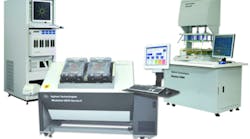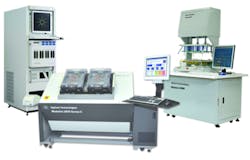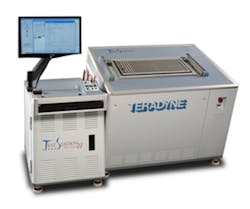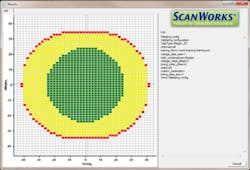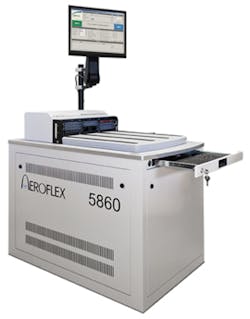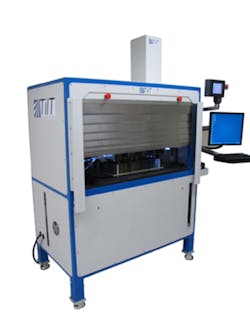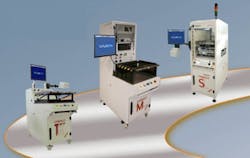Systems and Software Support PCB Test
For testing PCBs, test engineers have a variety of options ranging from venerable in-circuit testers and flying probers to functional testers and the latest in embedded-instrument technology. Undoubtedly, PCB physical access is increasingly limited as component sizes shrink and test points disappear—either because there is simply no room for them or because they would pose unacceptable loading on sensitive circuitry.
Nevertheless, in-circuit test retains a key role in high-volume circuit-assembly test, and flying probers continue to serve low-volume and new-product-introduction (NPI) test. Indeed, an effective test strategy probably will take advantage of nails and probes as well as functional test and the latest in embedded test technology.1
According to NK Chari, director of worldwide marketing and support for the Agilent Technologies Measurement Systems Division, “In today’s world with smaller and increasingly complex components that have higher speed signals, customers are challenged to develop an effective test strategy. Most organizations today try to put the right tests in the right place to build an optimal test strategy, ensure that fault coverage is predictable, and minimize the risk of product recalls.”
Agilent provides a line of products for board test, including the TS-8900 Automotive Functional Test System as well as the Medalist i3070 Series 5 Medalist i1000D In-Circuit Test Systems (Figure 1). Chari said, “Agilent’s ICT platform offers solutions from design and validation to prototyping, NPI, and mass manufacturing. For instance, the i1000D diagnostic test set can be implemented for ICT at the design and validation stage without the need to develop fixtures.” He added that while flying probers can be used for NPI applications, they can have test times of 10 minutes per board vs. seconds for an i1000D.
Figure 1. TS-8900 Functional Test System and Medalist i3070 Series 5 and Medalist i1000D In-Circuit Test Systems
Courtesy of Agilent Technologies
Chari added, “For users in the high-end network communications space, we have customized ICT solutions to help meet their high node-count needs. Similarly, our functional test systems offer users the versatility to carry out tests at the early stages of product design and development. We also incorporated extensive in-built libraries to help test engineers speed up deployment when the product enters mass manufacturing stage.”
Teradyne has been augmenting its family of TestStation In-Circuit Testers (Figure 2) with two options that support functional test: the Multi-Function Application Board and the PXI Expansion Board. The TestStation Multi-Function Application Board allows manufacturers to plug specially designed application modules directly into the TestStation system to expand the in-circuit tester’s functionality. Teradyne’s PXI Expansion Board enables manufacturers to expand the functionality of ICT by supporting the installation of commercial off-the-shelf PXI instruments in a specially designed chassis that plugs directly into an accessory or pin board slot of TestStation In-Circuit Test Systems.
Figure 2. TestStation In-Circuit Test System
Courtesy of Teradyne
“Both of these new options for TestStation are designed to make it easy to integrate functional test capability and custom circuitry directly into the test system,” said Teradyne marketing director Bobby Griffis. “The flexible design allows manufacturers to integrate functionality into the ICT test stage that often is performed at separate test stages on the production floor. Using the Multi-Function Application Board or PXI Expansion Board to expand the system’s test capabilities is beneficial when manufacturers are able to combine multiple test stages—such as board programming, functional test, and system test—into a single ICT test stage. The benefits of consolidation include reduced fixture and tooling costs, lower handling costs, reduced development costs, fewer test operators, faster production beat rate, and greater system utilization.”
Griffis said TestStation is scalable from 256 pins to 7,680 pins, and users can customize the system for each application—purchasing what they need today and adding capabilities later. He noted that TestStation can incorporate Teradyne’s UltraPin II Driver/Sensor with SafeTest protection technologies to test ultra low-voltage devices. In addition, he said, TestStation features digital, vectorless, boundary-scan, and analog test capabilities.2
Indeed, in-circuit test equipment makers consider boundary scan to be a complementary technology, and in fact, Chari at Agilent said, “Boundary scan test is a subset of ICT technology.” Boundary scan, he noted, is available as part of an in-circuit system or independently.
Griffis said that Teradyne’s strategy for boundary scan centers on the company’s BasicSCAN and Scan Pathfinder tools for TestStation. However, he noted that customers may want to use benchtop solutions from companies including Corelis, GOEPEL, and JTAG Technologies at the NPI stage. To support such customers, he said, Teradyne offers partnerships with select boundary-scan vendors or application-support third-party boundary-scan products. The partnerships, he said, provide greater levels of integration while application-level support includes co-authored documentation.
Boundary-Scan Solutions
Griffis cited Symphony as an advanced boundary-scan solution designed in partnership with JTAG Technologies for manufacturers using the TestStation in-circuit test system. “Because boundary-scan and ICT are complementary test methodologies, this combination of test techniques provides an optimal test strategy with the lowest overall cost and maximum fault coverage,” he said. (Symphony implementations also are available for other ICT systems, including the Agilent 3070.)
Glenn Woppman, president and CEO of ASSET InterTech, cited collaboration with Teradyne products other than the TestStation. Said Woppman, “Over the past year, Teradyne, a leading ATE provider, and ASSET have collaborated on the integration of ScanWorks boundary-scan test tools into Teradyne’s Di-Series and PXI Express-based High-Speed Subsystem (HSSub) instruments for large-scale test systems in defense/aerospace.” The collaboration addressed Teradyne’s Spectrum 9100 functional test platform and Lockheed Martin’s LM-STAR.
“As a result, PCBs can be tested with ScanWorks’ extensive structural boundary-scan test capabilities on large-scale ATE systems equipped with Teradyne’s instruments,” said Woppman. “In addition, the ScanWorks boundary-scan tests that have been developed in the lab to validate and bring up PCB prototypes can be directly migrated to the Teradyne-based ATE testers because the same ScanWorks runtime software is on the ATE systems,” he continued.
Woppman elaborated on the company’s embedded instrument technology (Figure 3): “All of the tools for the ScanWorks platform for embedded instruments are targeted at PCB and assembly test.” In addition to the integration with Teradyne instruments, he cited FPGA-controlled test (FCT), the high-speed I/O (HSIO) validation tool, and tools that support the IEEE P1687 Internal JTAG (IJTAG) standard. “All of these tools can be used in board and assembly test applications,” he said.
Figure 3. Eye Diagram Generated by the ScanWorks Embedded Instrument Platform
Courtesy of ASSET InterTech
Woppman said ASSET’s technology can serve a variety of stages. “Because of the scalability and versatility of embedded instrumentation in general,” he said, “the ScanWorks platform for embedded instruments can be deployed across a broad spectrum of test strategies, covering the entire PCB life cycle.”
GOEPEL electronic is another proponent of an embedded-instrumentation approach. “Our current focus is very much on Embedded System Access (ESA), where we use JTAG architectures to access and control test resources embedded in onboard devices such as processors and FPGAs,” said David Whetstone, director of North American sales and business development for GOEPEL. ESA, he said, permits the use of already present debug capabilities of a processor to perform high-speed and functional tests and to temporarily program embedded instrumentation IP into an FPGA. “Working in conjunction with traditional intrusive test approaches such as bed-of-nails or flying prober, these capabilities allow us to perform more testing by way of JTAG/boundary scan than ever before, reducing test times and fixture complexity,” Whetstone said.
Whetstone agreed with Woppman of ASSET that embedded instruments can serve various stages of a product’s life: “JTAG/boundary scan in general is very applicable not only during full product production, but throughout the entire product test and life cycles, and embedded system access is even useful for product return or field debug.” He concluded by saying, “New standard developments like IEEE P1687 (IJTAG) and new features specified in the upcoming revision of IEEE 1149.1 will further enhance the utility of embedded system access techniques for board and system-level test applications.”
An ATE Selection
Other firms making ATE systems for PCB test include Aeroflex, Everett Charles Technologies, Sieca, and Digitaltest. Kevin Tomkins, ATE product manager at Aeroflex, described his firm’s 5800 Series as a multi-configuration, multi-functional test system that is designed to meet the ever-changing needs of today’s electronic manufacturing environment. The system adopts an open approach to both hardware and software. “The open software architecture allows analog in-circuit program generation using CAPG [computer-assisted program generator] but also facilitates integration with applications written using third-party software such as NI TestStand, NI LabVIEW, C#, and VB.NET—in short any platform that is .NET compliant,” he said.
Tomkins added, “The open hardware architecture allows configurable chassis and interface styles to accommodate low-cost analog ICT through to high-integrity analog and digital functional test solutions. The integrated 21-slot PXI-based backplane enables the user to implement solutions using not only Aeroflex PXI modules but also modules from any PXI supplier.” The 5800 Series comprises three body styles, the 5860 (Figure 4), 5830, and 5820.
Figure 4. 5800 Series Multi-Configuration Multi-Functional Test System
Courtesy of Aeroflex
Other Aeroflex testers, Tomkins said, include the 5220 Series, a compact analog ICT system that provides a high level of performance and measurement accuracy, and the 4200 Series, a range of manufacturing ICT test systems offering a variety of analog and digital high-speed test methods to maximize throughput and test coverage.
Everett Charles Technologies (ECT) recently announced that its Fixture and Service Group (FSG) has released the new Tilt Tester (Figure 5), a fast NPI tester with low overall cost of test. The Tilt Tester features test and diagnostic capabilities, fast test times, and improved fault coverage compared with flying probers. It is capable of testing PCB assemblies up to 25” x 31” with up to 10,000 nets. Tilt Tester fixtures and test programs average 33% of the cost of conventional ICT, the company reported, and can be delivered in less than half the time normally required for conventional ICT programs and fixtures. Additionally, test access is increased with the capability to test 0.015” (0.38 mm) targets on 0.024” (0.6 mm) spacing. Backplanes also can be tested.
Figure 5. Tilt Tester for NPI Applications
Courtesy of Everett Charles Technologies
Digitaltest offers ICT, functional, and flying probe test as well as software tools. Products include the second-generation Condor Flying Probe System and QMAN Quality Management Software.
Seica offers its COMPACT line of in-circuit and functional testers (Figure 6) based on the company’s core software/hardware VIP platform, but it’s specialized for the automotive industry. It includes systems dedicated to ICT, onboard programming, and functional and end-of-line board testing with manual or fully automated UUT loading/downloading. The systems can run programs implemented in Seica’s VIVA software as well as NI LabVIEW and NI TestStand.
Figure 6. COMPACT Line of In-Circuit and Functional Testers
Courtesy of Seica
Seica also offers flying probers, including the Pilot V8, which is equipped with eight mobile probes on both sides of the UUT and able to deploy 12 different test techniques ranging from ICT to functional test, boundary scan, optical inspection, and thermal scan. In addition to production testing, it supports repair and reverse engineering of electronic boards. Its vertical architecture enables true simultaneous double-side testing, and it can test two identical UUTs simultaneously with a single test program.
Selecting Test Technologies
With the variety of test systems and software available, it can be difficult to determine the optimum test flow. Aster Technologies is one firm looking to simplify the task. It offers TestWay Express—an integrated approach that enables electronic manufacturers to optimize the design-to-delivery flow by defining the manufacturing line, including a combination of assembly, inspection, and test machines; placing test probes to maximize the coverage and minimize the fixture costs; estimating test coverage for each individual strategy using theoretical models; generating input files for each test stage that reflect the test options for the selected strategy; measuring actual test coverage by importing the post-debug test program or coverage data; and comparing the early estimation with the actual measured test program coverage, identifying gaps in the overall strategy.
ASTER reported it has developed output processors for a wide range of test, inspection, and assembly machines from companies including Acculogic, Aeroflex (the 4200 Series), Agilent (the i3070), ASSET InterTech, CheckSum, Corelis, GOEPEL, JTAG Technologies, MIRTEC, SPEA (including the 3030 Series ICT system and 4030 Series flying prober), Takaya (including the APT8400/94xx/9600 Series flying probers), Teradyne, and TRI (including the TR518 manufacturing defects analyzer and 5001 combined manufacturing defects analyzer, ICT system, and functional test system).
Aster has recently released Documentor and Engineering Change Order (ECO) modules that can be implemented as part of Aster’s QuadView PCB visualization tool or as part of TestWay Express. Documentor is a document management tool that allows creation of comprehensive shop floor documentation and the formatting of testability analysis reports. The ECO tool facilitates post-fabrication PCB modifications.
Increasing Automation
Expect innovation to continue to address customer needs. For example, Chari at Agilent said the company has heard from its customers their need to maintain quality irrespective of manufacturing footprints and staff experience. So in 2013, he said, “In-circuit test users are going to see ICT automation taken to a whole new level—we will be offering in-line ICT that is easy to use and maintain, [and we will offer] more versatile form factors that can help our customers overcome the challenges of tight manufacturing space.”
In addition, Chari said, “We are improving throughput with a new functional test system for automotive systems and other industrial electronics. This new PXI-based test system will be faster than current-generation solutions by at least 20% to 30%.” Chari said the company will share more details on its new board-test initiatives at Apex Expo 2013 Feb. 19-21 in San Diego.
And while ICT powerhouses are making use of technologies like PXI, companies like PXI pioneer National Instruments are focusing on using their technologies to address the PCB and circuit-assembly test markets. Sarah Ryan, NI’s product marketing manager for automated test, said, “National Instruments offers a complete software and hardware platform, allowing you to build a software-defined test system that meets your exact test requirements. With this platform, you gain the assurance of ongoing technology support and the flexibility to customize your instrumentation as your needs change.”
Honeywell China Company is one organization that has employed NI products in such applications. Honeywell reported having developed a flexible, easy-to-use function circuit test (FCT) system using PXI and NI LabVIEW to cut test system costs in half. Honeywell’s Wei Wang said, “By developing our new FCT system with PXI and LabVIEW, we greatly reduced duplication of engineering effort and can more easily share resources. We successfully applied this solution to our production lines, resulting in stable and reliable PCB testing.”3
Specific products that NI offers for PCB test applications, Ryan said, include the NI PXIe-5644R RF Vector Signal Transceiver—which she described as a software-designed instrument that combines a vector signal generator and vector signal analyzer with a user-programmable FPGA into a single PXI modular instrument. In addition, NI offers the NI SwitchBlock for PXI, an expandable, high-density switching solution developed specifically for automated test systems with large numbers of channels. NI SwitchBlock integrates with NI Switch Executive switch management software to provide a streamlined, intuitive option for switch configuration, routing, programming, and maintenance. “Highly flexible switching often serves as the backbone of PCB test systems,” Ryan said.
Finally, Ryan said, “The new NI PXIe-4143 Source Measure Unit (SMU) features the highest channel density of any SMU on the market and one of the fastest sample rates, making it ideal for testing multiple points of a PCB in parallel.” She concluded, “These products often are used to build functional test systems for PCBs or combined functional/structural testers, among others.”
As this article goes to print, National Instruments is planning to release its annual Automated Test Outlook, which promises to expand on what vendors are looking for in test systems. A special online-exclusive post complementing this print-edition special report will offer more insights on PCB test as well as more information on NI and other vendors’ perspectives on automated test. Visit www.evaluationengineering.com to view the exclusive online content. In particular, Tomkins of Aeroflex elaborates on the role of ICT, functional test, vectorless test, boundary scan, and in-system programming. Woppman of ASSET InterTech discusses FCT, IJTAG, platform scalability, and the role of non-intrusive embedded instrumentation.
That’s all in support of this conclusion from Woppman: “We believe that there is a paradigm shift going on in the test and measurement industry. As PCB assemblies become more and more complex with multiple layers, extremely fast chips and onboard high-speed buses, and new multicore and multi-die device packages, the older legacy external test equipment that relies on probing PCBs is giving way to software-driven embedded instrumentation that is internal to devices and PCBs. This testing from the inside out instead of from the outside in is made possible by the soft access mechanism incorporated in the IEEE 1149.1 boundary-scan standard’s JTAG access port.”
Clearly, ATE proponents see the benefits of boundary scan, but they also see a bright future for their systems as well. Concluded Chari at Agilent, “The industry continues to use ICT because it offers a great deal of value—many approaches can find a defect, but what customers struggle with is why that defect occurred. ICT, including boundary scan as part of the test environment, is one of the best ways to find and diagnose defects effectively at a reasonable price.”
References
1. Nelson, R., “Embedded Test Complements Boundary Scan,” EE-Evaluation Engineering, October 2012.
2. Suto, A.J., “Principles of Analog In-Circuit Testing,” EE-Evaluation Engineering, December 2012.
3. Wang, W., Developing a Functional Circuit Test System Using LabVIEW and PXI, National Instruments, Case Study.
